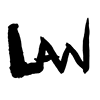My work is a play on the traditional idea of landscape painting. To arrive at my image, I use found photographs that guide the spatial dimensions of my work. This element of chance changes the inherent relationship between painting and representation, undoing the [traditional] building blocks of painting to think about nature in a more abstract, suggestive way. This process involves layering one pictorial structure (usually from a photograph) on top of the blank canvas to find forms that are not readily apparent through direct observation. While the invention of photography freed painters from the necessity of representation, I subtly re-insert the skeleton of mechanical representation as the foundation for my landscapes, but then insist on the hand-made materiality of my work. Even though I think of my works as landscapes, I don’t necessarily need the viewer to focus on the painting’s structure (horizon line, sky, ground). Instead, I highlight the process of painting with pooling, dripping, scratching, scraping, and glazing. So while my paintings maintain the intrinsic idea of representation, the paint on the surface highlights the specificity of the medium, rather than simply imitating nature. Even while I disrupt painting’s age-old relationship to representation by foregrounding the tangibility of paint, I believe in the power of nature and painting’s ability to embody it. My landscapes then serve a dual purpose to both remind the viewer of the beauty of our natural surroundings while also thinking through the beauty of the properties of paint and how marks make up a form.

